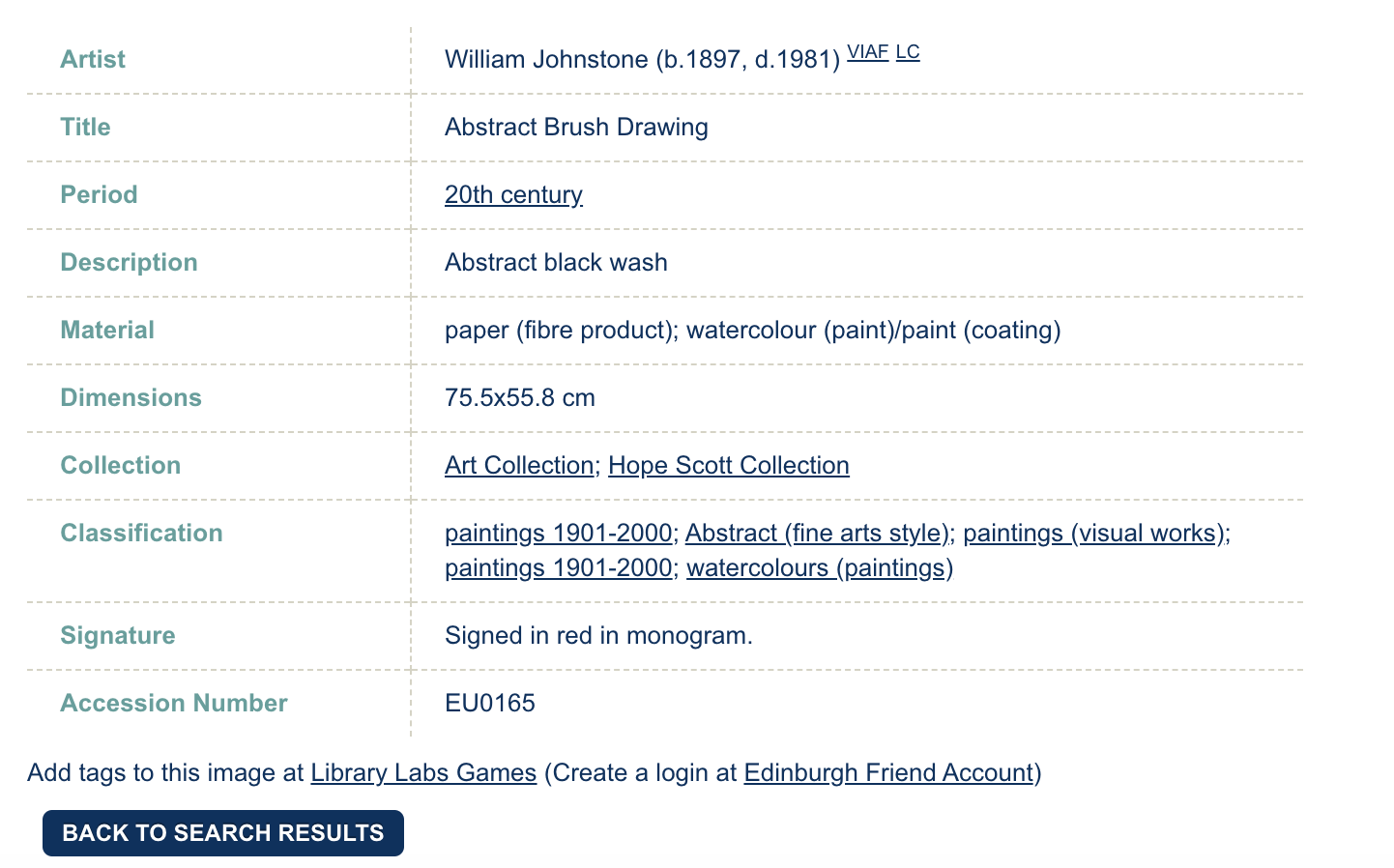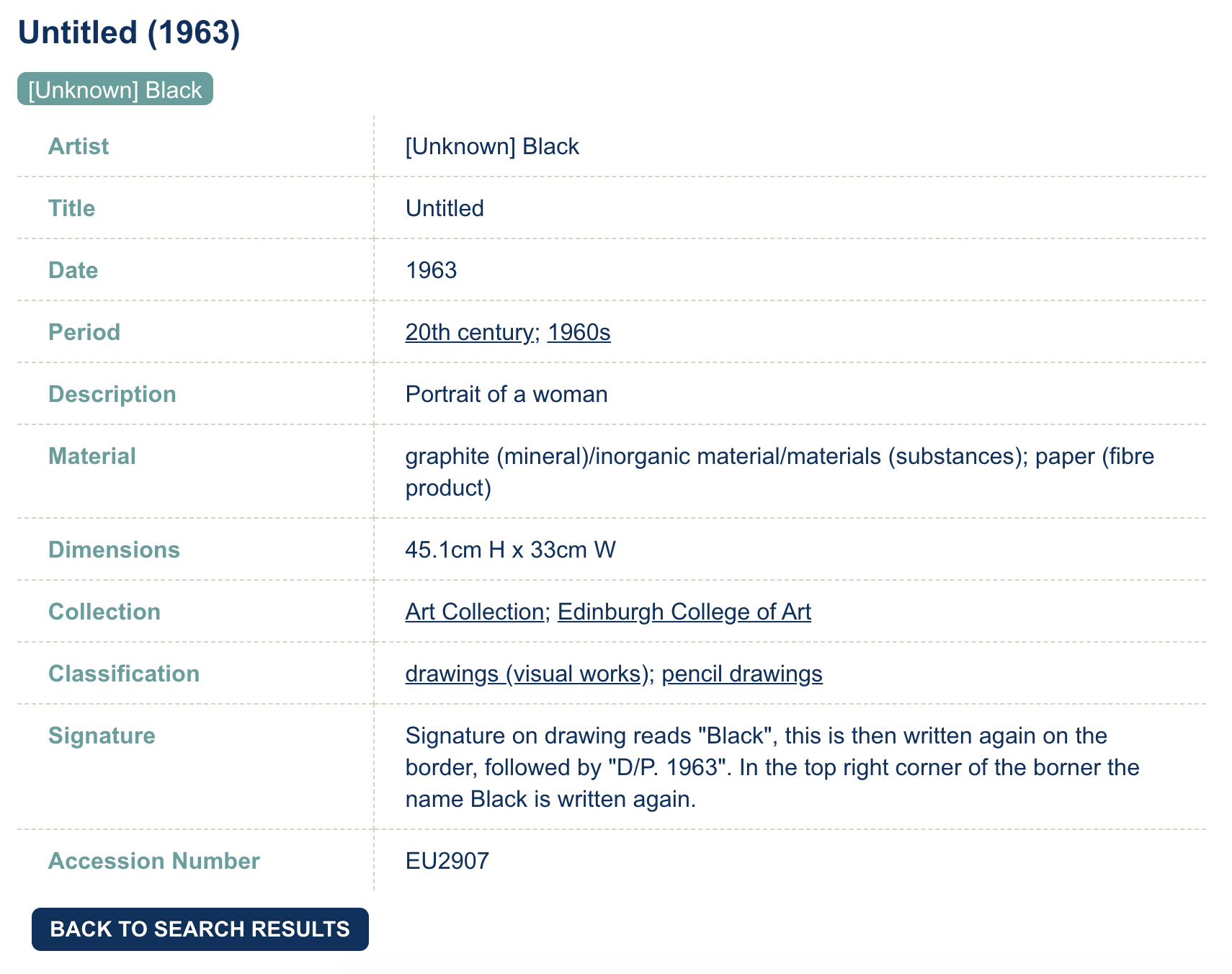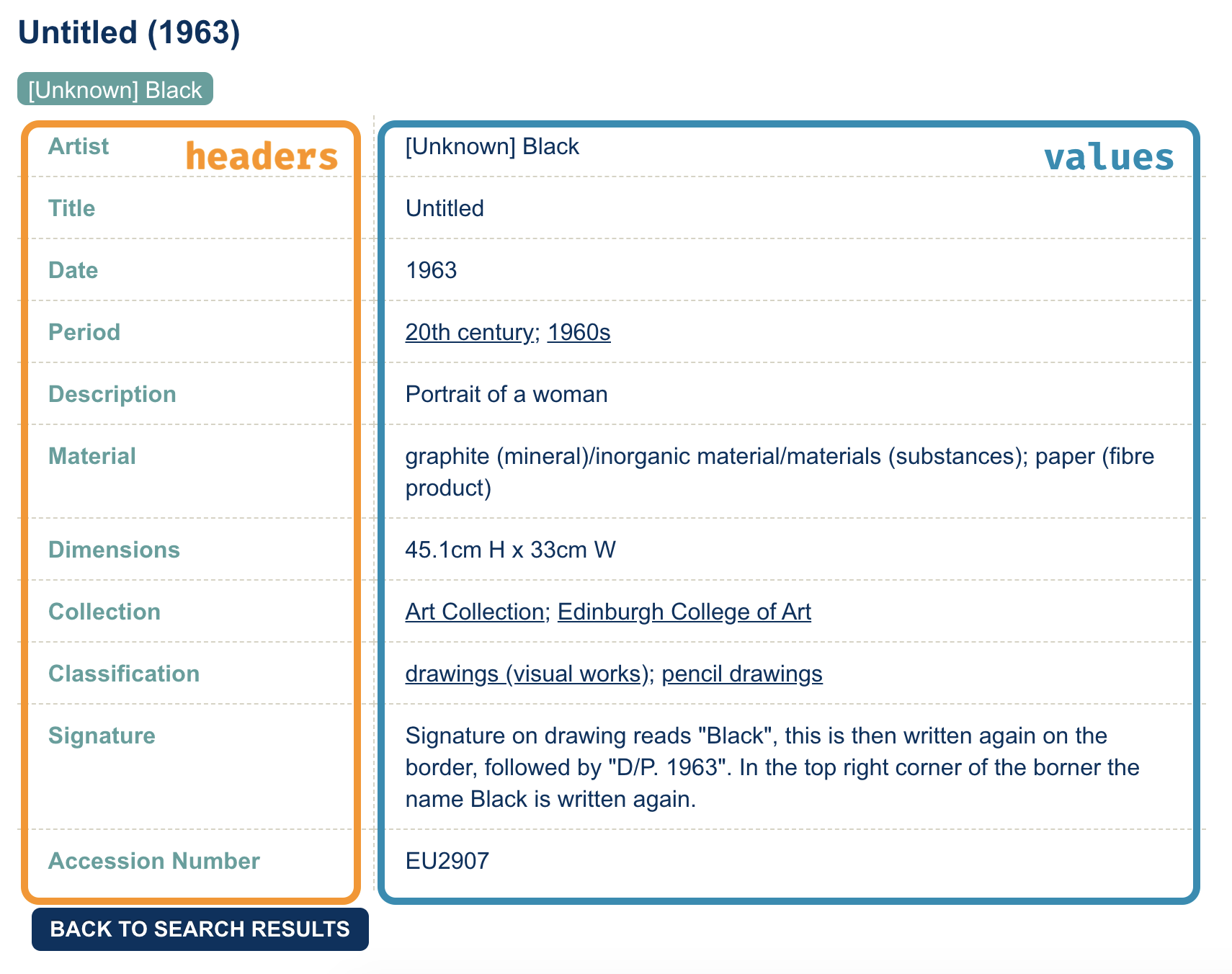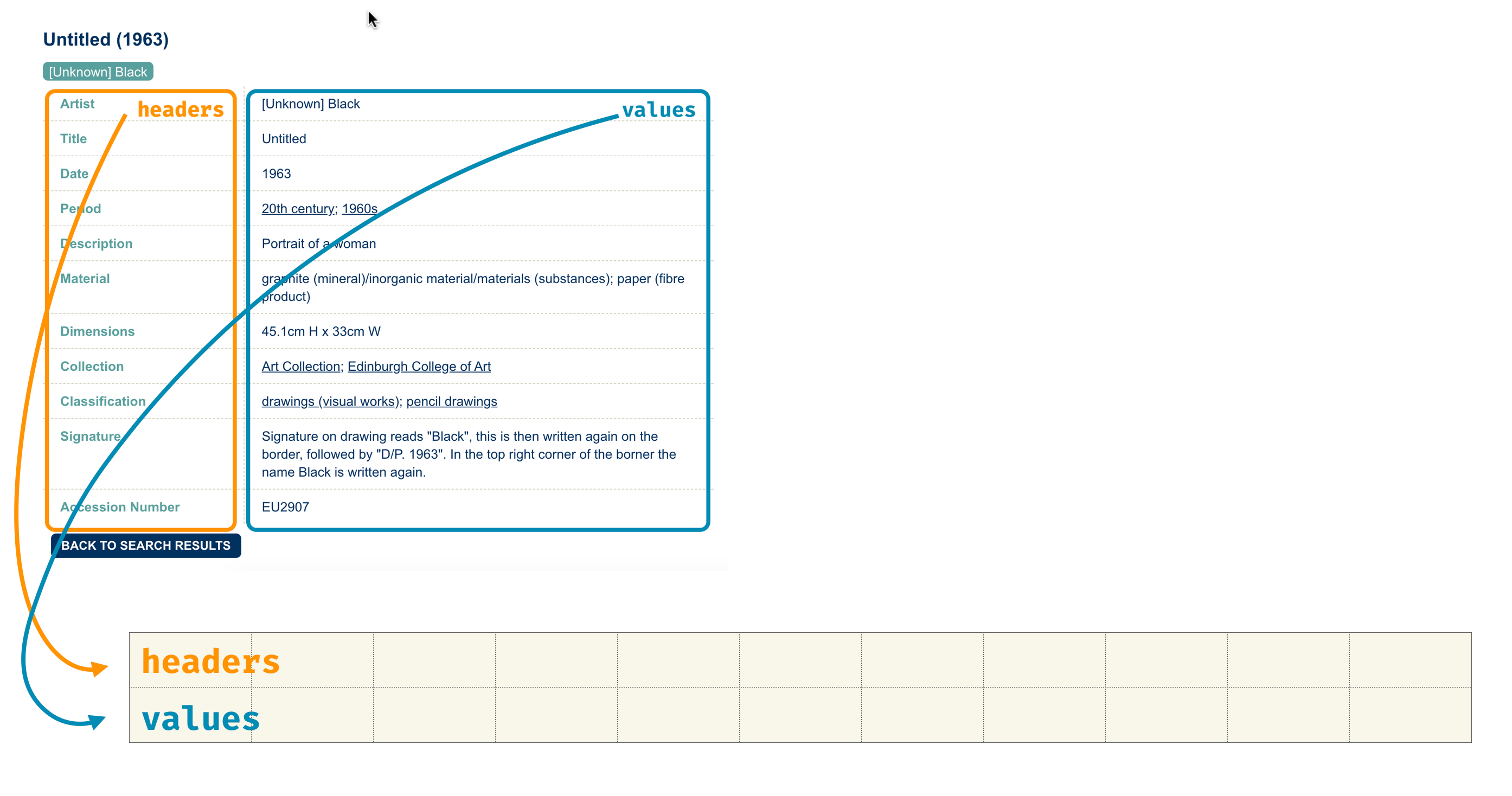Functions + automation
Prof. Maria Tackett
## # A tibble: 180 x 3## title artist link ## <chr> <chr> <chr> ## 1 Untitled (1959) William Gear https://collections.ed.ac.uk/a…## 2 Abstract Brush Drawing (2018) William Joh… https://collections.ed.ac.uk/a…## 3 Portrait of H.S. (1973) William Joh… https://collections.ed.ac.uk/a…## 4 Red and Black (1976) William Joh… https://collections.ed.ac.uk/a…## 5 Untitled (Landscape) (1943) William Joh… https://collections.ed.ac.uk/a…## 6 Black Sitka (1961) William Joh… https://collections.ed.ac.uk/a…## 7 Untitled (yellow triangle) (198… Mohamed Oun… https://collections.ed.ac.uk/a…## 8 Untitled - Abstract Print of Fo… Rena R. Sim… https://collections.ed.ac.uk/a…## 9 Untitled - Two Abstract Melting… Graeme Murr… https://collections.ed.ac.uk/a…## 10 Earth Element (1972) William Joh… https://collections.ed.ac.uk/a…## # … with 170 more rowsClick here to see the code used to scrape the data.
# load packages ----------------------------------------------------------------library(tidyverse)library(rvest)# first url ## set url first_info_url <- "https://collections.ed.ac.uk/art/./record/20144?highlight=*:*"## read page at urlpage <- read_html(first_info_url)## scrape headers headers <- page %>% html_nodes("th") %>% html_text()## scrape values values <- page %>% html_nodes("td") %>% html_text() %>% str_squish()## put together in a tibble and add link to help keep track ----tibble(headers, values) %>% pivot_wider(names_from = headers, values_from = values) %>% add_column(link = first_info_url)When should you write a function?
Whenever you’ve copied and pasted a block of code more than twice.
When should you write a function?
Whenever you’ve copied and pasted a block of code more than twice.
How many times will we need to copy and paste the code we developed to scrape additional data on each abstract art piece in the Edinburgh College of Art Collection?
When should you write a function?
Whenever you’ve copied and pasted a block of code more than twice.
How many times will we need to copy and paste the code we developed to scrape additional data on each abstract art piece in the Edinburgh College of Art Collection?
179 more times!
Why functions?
- Automate common tasks in a more powerful and general way than copy-and-pasting:
- You can give a function an evocative name that makes your code easier to understand.
- As requirements change, you only need to update code in one place, instead of many.
- You eliminate the chance of making incidental mistakes when you copy and paste (i.e. updating a variable name in one place, but not in another).
Why functions?
- Automate common tasks in a more powerful and general way than copy-and-pasting:
- You can give a function an evocative name that makes your code easier to understand.
- As requirements change, you only need to update code in one place, instead of many.
- You eliminate the chance of making incidental mistakes when you copy and paste (i.e. updating a variable name in one place, but not in another).
- Down the line: Improve your reach as a data scientist by writing functions (and packages!) that others use
How many inputs in the following code?
## set url ----first_info_url <- "https://collections.ed.ac.uk/art/./record/20144?highlight=*:*"## read page at url ----page <- read_html(first_info_url)## scrape headers ----headers <- page %>% html_nodes("th") %>% html_text()## scrape values ----values <- page %>% html_nodes("td") %>% html_text() %>% str_squish()## put together in a tibble and add link to help keep track ----tibble(headers, values) %>% pivot_wider(names_from = headers, values_from = values) %>% add_column(link = first_info_url)How many inputs in the following code?
## set url ----first_info_url <- "https://collections.ed.ac.uk/art/./record/20144?highlight=*:*"## read page at url ----page <- read_html(first_info_url)## scrape headers ----headers <- page %>% html_nodes("th") %>% html_text()## scrape values ----values <- page %>% html_nodes("td") %>% html_text() %>% str_squish()## put together in a tibble and add link to help keep track ----tibble(headers, values) %>% pivot_wider(names_from = headers, values_from = values) %>% add_column(link = first_info_url)Turn your code into a function
- Pick a short but informative name, preferably a verb.
scrape_art_info <-Turn your code into a function
- Pick a short but evocative name, preferably a verb.
- List inputs, or arguments, to the function inside
function. If we had more arguments the call would look likefunction(x, y, z).
scrape_art_info <- function(x){}Turn your code into a function
- Pick a short but informative name, preferably a verb.
- List inputs, or arguments, to the function inside
function. If we had more the call would look likefunction(x, y, z). - Place the code you have developed in body of the function, a
{}block that immediately followsfunction(...).
scrape_art_info <- function(x){ # code we developed earlier to scrape info # on single art piece goes here}scrape_art_info <- function(x){ # read page at url ---- page <- read_html(x) # scrape headers ---- headers <- page %>% html_nodes("th") %>% html_text() # scrape values ---- values <- page %>% html_nodes("td") %>% html_text() %>% str_squish() # put together in a tibble and add link to help keep track ---- tibble(headers, values) %>% pivot_wider(names_from = headers, values_from = values) %>% add_column(link = x)}Function in action
scrape_art_info(uoe_art$link[1]) %>% glimpse()## Rows: 1## Columns: 11## $ Artist <chr> "William Gear (b.1915, d.1997)"## $ Title <chr> "Untitled"## $ Date <chr> "1959"## $ Period <chr> "20th century; 1950s"## $ Description <chr> "abstract with splashes of watery blue and bright …## $ Material <chr> "acrylic paint/paint (coating)"## $ Collection <chr> "Art Collection"## $ Classification <chr> "Abstract (fine arts style); paintings (visual wor…## $ Signature <chr> "signed and dated lower right hand corner"## $ `Accession Number` <chr> "EU0975"## $ link <chr> "https://collections.ed.ac.uk/art/./record/20144?h…
Function in action
scrape_art_info(uoe_art$link[2]) %>% glimpse()## Rows: 1## Columns: 11## $ Artist <chr> "William Johnstone (b.1897, d.1981) VIAF LC"## $ Title <chr> "Abstract Brush Drawing"## $ Period <chr> "20th century"## $ Description <chr> "Abstract black wash"## $ Material <chr> "paper (fibre product); watercolour (paint)/paint …## $ Dimensions <chr> "75.5x55.8 cm"## $ Collection <chr> "Art Collection; Hope Scott Collection"## $ Classification <chr> "paintings 1901-2000; Abstract (fine arts style); …## $ Signature <chr> "Signed in red in monogram."## $ `Accession Number` <chr> "EU0165"## $ link <chr> "https://collections.ed.ac.uk/art/./record/388?hig…
What goes in / what comes out?
- They take input(s) defined in the function definition
function([inputs separated by commas]){ # what to do with those inputs}- By default they return the last value computed in the function
scrape_page <- function(x){ # do bunch of stuff with the input... # return a tibble tibble(...)}- You can define more outputs to be returned in a list as well as nice print methods (but we won't go there for now...)
What is going on here?
add_2 <- function(x){ x + 2 1000}add_2(3)## [1] 1000add_2(10)## [1] 1000Naming functions
"There are only two hard things in Computer Science: cache invalidation and naming things." - Phil Karlton
Naming functions
"There are only two hard things in Computer Science: cache invalidation and naming things." - Phil Karlton
- Names should be short but clearly evoke what the function does
Naming functions
"There are only two hard things in Computer Science: cache invalidation and naming things." - Phil Karlton
- Names should be short but clearly evoke what the function does
- Names should be verbs, not nouns
Naming functions
"There are only two hard things in Computer Science: cache invalidation and naming things." - Phil Karlton
- Names should be short but clearly evoke what the function does
- Names should be verbs, not nouns
- Multi-word names should be separated by underscores (
snake_caseas opposed tocamelCase)
Naming functions
"There are only two hard things in Computer Science: cache invalidation and naming things." - Phil Karlton
- Names should be short but clearly evoke what the function does
- Names should be verbs, not nouns
- Multi-word names should be separated by underscores (
snake_caseas opposed tocamelCase) - A family of functions should be named similarly (
scrape_page,scrape_art_infoORstr_squish,str_trim,str_removeetc.)
Naming functions
"There are only two hard things in Computer Science: cache invalidation and naming things." - Phil Karlton
- Names should be short but clearly evoke what the function does
- Names should be verbs, not nouns
- Multi-word names should be separated by underscores (
snake_caseas opposed tocamelCase) - A family of functions should be named similarly (
scrape_page,scrape_art_infoORstr_squish,str_trim,str_removeetc.) - Avoid overwriting existing (especially widely used) functions
# JUST DON'Tmean <- function(x){ x * 3 }Define the task
- Goal: Scrape info on all 180 abstract art in the collection
- So far:scrape_art_info(uoe_art$link[1])scrape_art_info(uoe_art$link[2])scrape_art_info(uoe_art$link[3])
- What else do we need to do?
- Run the
scrape_art_info()function on all 180 links - Combine the resulting data frames from each run into one giant data frame with 180 rows
- Run the
Inputs
You now have a function that will scrape the relevant info on art pieces given the URL of its individual info page. Where can we get a list of URLs of each of the art pieces in the collection?
Inputs
You now have a function that will scrape the relevant info on art pieces given the URL of its individual info page. Where can we get a list of URLs of each of the art pieces in the collection?
From the original data frame!
uoe_art## # A tibble: 180 x 3## title artist link ## <chr> <chr> <chr> ## 1 Untitled (1959) William Gear https://collections.ed.ac.uk/a…## 2 Abstract Brush Drawing (2018) William Joh… https://collections.ed.ac.uk/a…## 3 Portrait of H.S. (1973) William Joh… https://collections.ed.ac.uk/a…## 4 Red and Black (1976) William Joh… https://collections.ed.ac.uk/a…## 5 Untitled (Landscape) (1943) William Joh… https://collections.ed.ac.uk/a…## 6 Black Sitka (1961) William Joh… https://collections.ed.ac.uk/a…## 7 Untitled (yellow triangle) (198… Mohamed Oun… https://collections.ed.ac.uk/a…## 8 Untitled - Abstract Print of Fo… Rena R. Sim… https://collections.ed.ac.uk/a…## 9 Untitled - Two Abstract Melting… Graeme Murr… https://collections.ed.ac.uk/a…## 10 Earth Element (1972) William Joh… https://collections.ed.ac.uk/a…## # … with 170 more rowsAutomation
How can we tell R to apply the scrape_art_info() function to each link in uoe_art$link?
Automation
How can we tell R to apply the scrape_art_info() function to each link in uoe_art$link?
- Option 1: Write a for loop, i.e. explicitly tell R to visit a link, apply the function, store the result, then visit the next link, apply the function, append the result to the stored result from the previous link, and so on and so forth.
Automation
How can we tell R to apply the scrape_art_info() function to each link in uoe_art$link?
- Option 1: Write a for loop, i.e. explicitly tell R to visit a link, apply the function, store the result, then visit the next link, apply the function, append the result to the stored result from the previous link, and so on and so forth.
- Option 2: Map the function to each element in the list of links, and let R take care of the storing and appending of results.
Automation
How can we tell R to apply the scrape_art_info() function to each link in uoe_art$link?
- Option 1: Write a for loop, i.e. explicitly tell R to visit a link, apply the function, store the result, then visit the next link, apply the function, append the result to the stored result from the previous link, and so on and so forth.
- Option 2: Map the function to each element in the list of links, and let R take care of the storing and appending of results.
We'll go with Option 2 for now.
How does mapping work?
Suppose we have exam 1 and exam 2 scores of 4 students stored in a list...
exam_scores <- list( exam1 <- c(80, 90, 70, 50), exam2 <- c(85, 83, 45, 60))How does mapping work?
Suppose we have exam 1 and exam 2 scores of 4 students stored in a list...
exam_scores <- list( exam1 <- c(80, 90, 70, 50), exam2 <- c(85, 83, 45, 60))...and we find the mean score in each exam
map(exam_scores, mean)## [[1]]## [1] 72.5## ## [[2]]## [1] 68.25...and suppose we want the results as a numeric (double) vector
map_dbl(exam_scores, mean)## [1] 72.50 68.25...and suppose we want the results as a numeric (double) vector
map_dbl(exam_scores, mean)## [1] 72.50 68.25...or as a character string
map_chr(exam_scores, mean)## [1] "72.500000" "68.250000"map_something
Functions for looping over an object and returning a value (of a specific type):
map()- returns a listmap_lgl()- returns a logical vectormap_int()- returns an integer vectormap_dbl()- returns a double vectormap_chr()- returns a character vectormap_df()/map_dfr()- returns a data frame by row bindingmap_dfc()- returns a data frame by column binding- ...
Go to each page, scrape art info
- Map the
scrape_art_info()function - to each element of
uoe_art$link - and return a data frame by row binding
uoe_art_info <- map_df(uoe_art$link, scrape_art_info)## # A tibble: 180 x 14## Artist Title Date Period Description Material Collection Classification## <chr> <chr> <chr> <chr> <chr> <chr> <chr> <chr> ## 1 Willi… Unti… 1959 20th … abstract w… acrylic… Art Colle… Abstract (fin…## 2 Willi… Abst… <NA> 20th … Abstract b… paper (… Art Colle… paintings 190…## 3 Willi… Port… 1973 20th … Charcoal o… charcoa… Art Colle… Abstract (fin…## 4 Willi… Red … 1976 20th … Abstract b… ink/coa… Art Colle… paintings 190…## 5 Willi… Unti… 1943 20th … Abstract b… paper (… Art Colle… paintings 190…## 6 Willi… Blac… 1961 20th … Black land… canvas … Art Colle… oil paintings…## 7 Moham… Unti… 1989 20th … abstract t… acrylic… Art Colle… Abstract (fin…## 8 Rena … Unti… 1982 20th … Print in b… paper (… Art Colle… fine art; Abs…## 9 Graem… Unti… 1985… 20th … Print of a… Print Art Colle… fine art; pri…## 10 Willi… Eart… 1972 20th … Abstract b… ink/coa… Art Colle… paintings 190…## # … with 170 more rows, and 6 more variables: Signature <chr>, `Accession## # Number` <chr>, link <chr>, Dimensions <chr>, Subject <chr>, `Alternative## # Title` <chr>## Rows: 180## Columns: 14## $ Artist <chr> "William Gear (b.1915, d.1997)", "William Johnsto…## $ Title <chr> "Untitled", "Abstract Brush Drawing", "Portrait o…## $ Date <chr> "1959", NA, "1973", "1976", "1943", "1961", "1989…## $ Period <chr> "20th century; 1950s", "20th century", "20th cent…## $ Description <chr> "abstract with splashes of watery blue and bright…## $ Material <chr> "acrylic paint/paint (coating)", "paper (fibre pr…## $ Collection <chr> "Art Collection", "Art Collection; Hope Scott Col…## $ Classification <chr> "Abstract (fine arts style); paintings (visual wo…## $ Signature <chr> "signed and dated lower right hand corner", "Sign…## $ `Accession Number` <chr> "EU0975", "EU0165", "EU0138", "EU0147", "EU0146",…## $ link <chr> "https://collections.ed.ac.uk/art/./record/20144?…## $ Dimensions <chr> NA, "75.5x55.8 cm", "45.7x40.6 cm", "77.4x58.4 cm…## $ Subject <chr> NA, NA, NA, NA, NA, NA, "abstract", NA, NA, NA, N…## $ `Alternative Title` <chr> NA, NA, NA, NA, NA, NA, NA, NA, NA, NA, NA, NA, N…What could go wrong?
uoe_art_info <- map_df(uoe_art$link, scrape_art_info)- This will take a while to run
- If you get
HTTP Error 429 (Too many requests)you might want to slow down your hits by modifying your function to slow it down by adding a random wait (sleep) time between hitting each link
scrape_art_info <- function(x){ # Sleep for randomly generated number of seconds # Generated from a uniform distribution between 0 and 1 Sys.sleep(runif(1)) # Rest of your function code goes here...}

